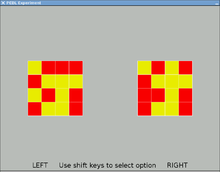Match-to-sample task
Match-to-Sample Task
Short-term memory for learned associations has been studied using the Match-to-Sample Task (and the related Delayed Match-To-Sample Task, and Non-match to sample task). The general versions of the task ask a participant to first encode a stimulus (often a light of a particular color, or a visual pattern), and later make a forced-choice response among options where one corresponds to that stimulus. The stimulus that is encoded is commonly referred to as the sample stimulus, while the stimuli that the participant must choose from are referred to as the comparison stimuli[1] The correct response options typically, but not always, corresponds directly in some way to the stimulus (i.e., its color is the same).

Historical Background
Match to Sample tasks were developed in the during the era of behaviorism, and were described by, among others, B.F. Skinner[2][3][4] In its early form[4] A pigeon would be presented with a colored light stimulus sample. It would then proceed to peck the sample and then be presented with two comparison stimuli. One comparison stimulus matches the sample (either because it is an identical color, or because the animal has learned an association such as green means left) and the other does not match. If it chooses (pecks) the matching comparison, then it is rewarded.[5]
A more complex version of the task has formed the basis for human-centered cognitive test batteries since the 1980s[6][7] This version of the task involves a 4X4 matrix pattern that is filled with yellow and red squares. Participants are alloted a specific amount of time to study the first pattern that appears on the screen. After the first pattern disappears, it is then replaced by a pair of matrices. One of these is the same as the previously viewed stimulus and one differs by one or more cells of the matrix. The participant then indicates which of the two was the presented stimulus. One trial of this tasks takes approximately 5–10 seconds.
Strengths and Weaknesses
The strengths of this procedure are that participants have a limited time to think, so if they are more aware/alert, they should make more correct responses. It has also been hypothesized to be impacted by alertness, but resilient to practice effects.
Match-to-sample tasks and Sleep Deprivation
The match-to-sample task has been shown to be an effective tool to understand the impact of sleep deprivation on short-term memory. One research study[8] compared performance on a traditional sequential test battery with that on a synthetic work task requiring subjects to work concurrently on several tasks, testing subjects every three hours during 64 hrs of sleep deprivation. Similarly, another study[9] used an event-related Functional magnetic resonance imaging of the neural networks underlying the encoding, maintenance, and retrieval phase in the task. This test was used to discover the reduction in pattern expressions with sleep deprivation for each subject and how it related to the change in performance on the delayed-match-to-sample task. It also expanded the prefrontal areas regarding Working memory and revealed substantial individual differences in performance. The test also reproduced findings of other working memory studies which demonstrated interactions between PFC and other parts of the brain.
Delayed Match-to-sample tasks and Working Memory
Delayed match-to-sample tasks, or DMTS, are very similar to match-to-sample tasks except before choosing the correct response, there is a short delay. This delay can vary in length in order to determine how long the subject can retain information in their working memory. If the subject responds correctly over fifty percent of the time, it shows that the subject has held that information (sample stimulus - see above) in memory. The amount of information that subjects can retain differs with species. For instance, a study by Grant in 1975, found that pigeons' ability to correctly choose the comparison stimuli (see above) declined as the delay between stimuli presentations increased. On average, a ten-second delay resulted in a correct response choice of around sixty-six percent. In a much more developed species, capuchin monkeys, D'Amato found (in 1973) that monkeys are able to choose the correct stimuli with a sixty-six percent rate, but with a much longer delay.[10]
References
- ↑ Mazur, J. E. (2013). Learning and behavior. (7th ed., pp. 226). New Jersey: Pearson Education, Inc.
- ↑ Skinner, B. F. (1950). Are theories of learning necessary? Psychological Review, 57, 193-216.
- ↑ Blough D S.. Delayed matching in the pigeon. J Exp Anal Behav. 1959 Apr;2:151–160.
- ↑ 4.0 4.1 C. B. Ferster (1960) Intermittent reinforcment of matching to sample in the pigeon. J Exp Anal Behav. 1960 July; 3(3): 259–272. http://www.ncbi.nlm.nih.gov/pmc/articles/PMC1404017/
- ↑ ("Models of Learning and Performance." Dr. Robert Cook's Homepage | Department of Psychology, Tufts University. N.p., n.d. Web. 24 Feb. 2012. <http://www.pigeon.psy.tufts.edu/avc/wright/.
- ↑ Englund, C. E., Reeves, D. L., Shingledecker, C. A., Thorne, D. R., & Wilson, K. P. (1987). Unified Tri-Service Cognitive Performance Assessment Battery (UTC-PAB). 1. Design and Specification of the Battery. Retrieved from http://stinet.dtic.mil/oai/oai?&verb=getRecord&metadataPrefix=html&identifier=ADA182480
- ↑ Perez, W. A., Masline, P. J., Ramsey, E. G., & Urban, K. E. (1987). Unified Tri-Services Cognitive Performance Assessment Battery: Review and Methodology. Retrieved from http://stinet.dtic.mil/oai/oai?&verb=getRecord&metadataPrefix=html&identifier=ADA181697
- ↑ Elsmore, T. F. (1995). A comparison of the effects of sleep deprivation on synthetic work performance and a conventional performance assessment battery. San Diego, Calif.: Naval Health Research Center.
- ↑ Habeck C, Rakitin BC, Moeller J, Scarmeas N, Zarahn E, Brown T, Stern Y. (2005). Brain research. Cognitive brain research
- ↑ Mazur, J. E. (2013). Learning and behavior. (7th ed., pp. 226-227). New Jersey: Pearson Education, Inc.